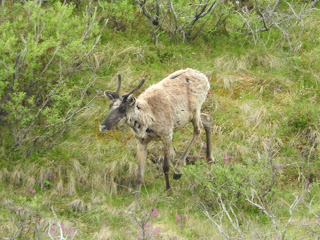Saturday, June 27, 2015
We are at Denali National Park in Alaska. We spent yesterday taking a 6.5 hour tour of
the park, but were unable to see Mt. McKinley.
Mt. McKinley is so large it creates it’s own climate, usually with
clouds and yesterday was no exception.
But the scenery is gorgeous. Denali encompasses 6 million acres. The bus took us about 50 miles into the park
and back, with a few stops along the way.
The road was mostly dirt and gravel.
They limit vehicle access to most of the park; hiking is
unlimited.
We did spot a few animals:
A young caribou.
Dall sheep
A hawk.
And a golden eagle.
He apparently had his eye on some prey, as he hovered over the same spot
for a long time, allowing Steve to get a good shot.
But the scenery stole the show. It was ever changing and we took way too many
pictures. It was hard to narrow them
down to just a few.
The glaciers created what are called braided rivers –
rivers with multiple channels that change often.
The haze in the upper right of the picture above is
smoke. As we turned around to head back
to the front of the park, the smoke from some of the forest fires in Alaska was
beginning to creep into the park. We
were lucky to have a relatively clear day.
There are over 400 active forest fires in Alaska. The later tours didn’t see nearly as much, as
more smoke kept creeping into the park.
We finished the day off with pizza at a local place that
had both a crust AND cheese I could have.
And it was good pizza! (Or as good
as a gluten free, dairy free pizza gets!)
I’m going to create another post or two on our previous
adventures, but stop now and try and get this posted.
Deb


















































